In this 4D case study, conducted in the Campos Basin, Brazil, we demonstrate that is possible to
extract reliable field production information with relaxed constraints on the acquisition
repeatability. We show how different streamer technology datasets can be combined to monitor
the production of the Albacora Leste field. The aim is that the 4D study will provide additional
reservoir production information on fluid saturation and pressure changes. This “opportunistic”
Albacora Leste 4D case study combined a 2005 Multi-Client Baseline dataset, acquired with
shallow towed conventional hydrophone streamer, with a 2022 Monitor dataset acquired with
deep towed multi-sensor streamer. One of the 4D imaging challenges was to accommodate the
two types of streamer and non-repeated shot positions for computing an accurate 4D signal.
Through specific 4D processing sequences and a 4D Least-Square Kirchhoff imaging approach,
we succeeded in improving the seismic signal resolution and were able to detect consistent fluid
saturation and pressure changes within thin sandstone layers in the reservoirs. The 4D Albacora
Leste project has enabled us to map and better understand the longstanding production of this
complex and compartmentalized reservoir composed of turbiditic stacked channels with the aim
of identifying new development opportunities.
Technical Library

